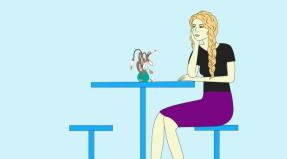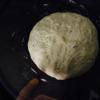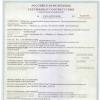Physical and hygienic characteristics of noise. The main physical and hygienic characteristics of noise. Spectral analysis of noise Physical and hygienic characteristics of noise
V.M. Panarin, A.A. Zuikova, V.L. Chizhova, N.A. Telegina
Tula State University,
Tula
In industry, agriculture and there are many types of transport professional activity associated with the possibility of exposure production noise . Of great importance is also domestic noise(household appliances, ventilation units, elevators, etc.).
Noise(from a hygienic point of view) is a complex of randomly combined sounds of various frequencies and intensities that adversely affect the human body.
Noise(from an acoustic point of view) are mechanical wave oscillations of particles of an elastic medium with small amplitudes, arising under the action of some emerging force. Oscillations of medium particles are conditionally called sound waves. The zone of audible or actually sound vibrations lies within 16 Hz - 20 kHz. Acoustic vibrations with a frequency below 16 Hz are called infrasounds, from 2 - 10 4 to 10 9 Hz - by ultrasound, above 10 9 Hz - hypersounds. The entire audible frequency range (16Hz - 20kHz) is divided into 11 octaves with average geometric frequencies of 31.5; 63; 125; 250; 500; 1000; 2000; 4000; 8000Hz.
physical characteristics:
1. Sound source power(W) - the total amount of energy that the sound source radiates into the surrounding space per unit of time.
2. Intensity (strength) of sound(W / m 2) - part of the total power per unit area normal to the background of the wave. That is, the acoustic power that reaches the sound receiver ( eardrum).
3. Sound pressure(Pa / (N / m 2)) - excessive oscillation in the medium in relation to the existing there before the appearance of sound waves.
4. Sound speed(m/s) is the speed at which E is transferred from particle to particle.
The minimum vibration energy that can cause the sensation of an audible sound is called hearing threshold(or threshold of perception). At a frequency of 1000 Hz, it is equal to 10 -12 W / m 2. Upper limit of hearing, threshold pain sensation at a frequency of 1000 Hz occurs at a sound intensity of 10 2 W / m 2.
In acoustics, instead of a scale of absolute values of sound intensity and sound pressure, they use relative logarithmic scale(on the decibel scale). This scale is expressed in belah(B) or decibels(dB) and falls within the range of 0 -140 dB (0 - 14B).
Decibel- a conventional unit that shows a given sound in logarithmic values more than the threshold of audibility. Decibel (dB) is a mathematical concept used to compare two quantities of the same name, regardless of their nature.
The intensity of a sound is subjectively felt as its loudness. The vibration frequency determines the pitch of the sound. The loudness level determines the level of sound intensity, taking into account the dynamic and frequency properties of the ear. The unit that characterizes the volume level is called the background. Background- shows the volume level of a sound of any frequency compared to the intensity of a standard tone (1000 Hz / sec), expressed in decibels. The frequency response distinguishes noise low frequency(16-350Hz), midrange(350 - 800Hz), high frequency(more than 800Hz). The auditory analyzer is more sensitive to high frequencies than to low ones, and therefore a differentiated approach to permissible noise levels is provided, depending on the frequency response, exposure time. In this case, it must be taken into account that tonal and impulse noise have the most adverse effect and their noise levels should be 5 dB. less values maximum allowable. The maximum permissible noise levels (broadband) are: in hospital wards 30 dBA, on the territory of the hospital up to 35 dBA, in the living room 30 dBA, in residential areas 45 dBA. In production, up to 80-85 dBA is allowed (for permanent jobs and work areas in industrial premises and on the territory of enterprises).
Table 1
The effect of noise on the body
Noise, being a general biological stimulus, affects all organs and systems, causing a variety of physiological changes. Factors aggravating the effect of noise: forced position of the body, neuro-emotional stress, vibration, adverse meteorological factors, exposure to dust, toxic substances.
Specific Action:
1. noise injury- associated with the influence of very high sound pressure (explosive work, testing of powerful engines). Clinic: sudden pain in the ears, damage to the eardrum up to its perforation.
2. hearing fatigue- due to the re-irritation of the nerve cells of the auditory analyzer and is expressed by a weakening of auditory sensitivity by the end of the working day. With chronic exposure to noise, this re-irritation causes the gradual development of occupational hearing loss (progressive hearing loss).
3. cochlear neuritis- develops slowly. It is preceded by adaptation to noise and the development of hearing fatigue. Initial stage: ringing in the ears, dizziness, perception of colloquial whisper speech is not impaired. It is based on the defeat of the sound-perceiving apparatus, atrophy begins in the area of \u200b\u200bthe main and lower curls of the cochlea, that is, in the part that perceives high tones, therefore, in initial stage characteristic threshold of perception at high sound frequencies (4000-8000 Hz). As the disease progresses, the perception threshold rises to medium, then to low frequencies. With a pronounced stage, the perception of whispered speech decreases, and hearing loss is formed.
Non-specific action:
Symptom complex "noise disease" includes functional disorders of the nervous and cardiovascular systems, gastrointestinal tract, endocrine glands in the form of neuroses, neurosthenia, astheno-vegetative syndrome with vascular hypertension, hypertension, inhibition of secretions of the gastrointestinal tract, dysfunction of the endocrine glands.
In production, the combined effect of noise and vibration is often encountered.
If familiar sounds suddenly disappear from the environment, then a person will experience significant inconvenience, excitement and even a feeling of causeless fear: after all, people are born and live in the world of sounds. It should not be forgotten that civilization has reached a high level of development thanks to the ability to communicate in the form of speech - one of the types of communication using sounds. However, noise is one of the main adverse production factors. Due to noise, workers experience faster fatigue, which leads to a decrease in productivity by 10 ... 15%, an increase in the number of errors in the performance of work process operations and, consequently, an increased risk of injury. With prolonged exposure to noise, the sensitivity of the hearing aid decreases, pathological changes occur in the nervous and cardiovascular systems.
Noise is a collection of sounds of varying strength and frequency (pitch) that change randomly over time. By their nature, sounds are mechanical vibrations of solids, gases and liquids in the audible frequency range (16...20,000 Hz). In air, a sound wave propagates from a source of mechanical vibrations in the form of zones of condensation and rarefaction. Mechanical vibrations are characterized by amplitude and frequency.
The oscillation amplitude determines the pressure and strength of the sound: the larger it is, the greater the sound pressure and the louder the sound. The essence of auditory perception consists in catching with the ear the deviation of air pressure created by a sound wave from atmospheric pressure. The value of the lower absolute sensitivity threshold of the auditory analyzer is 2-10~5 Pa at a frequency of 1000 Hz, and the upper threshold is 200 Pa at the same sound frequency.
The oscillation frequency affects auditory perception and determines! sound height. Oscillations with a frequency below 16 Hz constitute the region of infrasounds, and above 20,000 Hz - ultrasounds. With age (from about 20 years old), the upper limit of frequencies perceived by a person decreases: in middle-aged people up to 13 ... 15 kHz, in the elderly - up to 10 kHz or less. The sensitivity of the hearing aid increases with an increase in frequency from 16 to 1000 Hz, at frequencies of 1000 ... 4000 Hz it is maximum, and at a frequency of more than 4000 Hz it drops.
A physiological feature of the perception of the frequency composition of sounds is that the human ear reacts not to an absolute, but to a relative increase in frequencies: a doubling of the oscillation frequency is perceived as an increase in the pitch by a certain amount, called an octave. Therefore, it is customary to call an octave a frequency range in which the upper limit is twice as large as the lower one. The audible frequency range is divided into octaves with geometric mean frequencies of 31.5; 63; 125; 250; 500; 1000; 2000; 4000; 8000 and 16000Hz. Average geometric frequencies occupy, as it were, an intermediate position in the octave. They are determined from the expression
where fn and fv are the lower and upper values of the frequency in an octave, respectively.
In the hygienic assessment of noise, its intensity (strength) is measured and the spectral composition is determined by the frequency of the sounds included in it. Sound intensity is the amount of sound energy carried by a sound wave per unit of time and related to a unit of surface area perpendicular to the direction of wave propagation. Sound intensity values vary over a very wide range - from 10-12 to 10 W/m2. In connection with the strong stretching of the range of intensity changes and the peculiarities of the perception of sounds (see the Weber-Fechner law), logarithmic quantities are introduced - the intensity level and the sound pressure level, expressed in decibels (dB). When using a logarithmic scale, the sound intensity level is:
Li = 101g(I/I0),
sound pressure level:
where I and I0 are, respectively, the actual and threshold values of the sound intensity, W/m2: I0= 10-12 W/m2 at the reference frequency fe= 1000 Hz; p and P 0 - respectively, the actual and threshold sound pressure, Pa: p0 \u003d 2 * 10-5 Pa at fe \u003d 1000 Hz.
Rice. 19.1. Curves of equal loudness of sounds
It is convenient to use a logarithmic scale of sound pressure levels, since sounds that differ in strength by a factor of billions fall within the range of 130 ... 140 dB. For example, the sound pressure level created during normal human breathing is within 10 ... 15 dB, whisper - 20 ... 25, normal conversation - 50 ... 60, created by a motorcycle - 95 ... 100, engines jet aircraft on takeoff - 110 ... 120 dB. However, when comparing different noises, it must be remembered that a 70 dB noise level is twice as loud as a 60 dB noise level and four times as loud as a 50 dB noise level, which follows from the logarithmic scale. In addition, sounds of the same intensity but different frequencies are perceived differently by ear, especially at an intensity level of less than 70 dB. The reason for this phenomenon is the greater sensitivity of the ear to high frequencies.
In this regard, the concept of sound loudness is introduced, the units of which are backgrounds and sons. The loudness of sounds is determined by comparing them with a reference sound with a frequency of 1000 Hz. For a reference sound, units of its intensity in decibels are equated to backgrounds (Fig. 19.1). So, the loudness of a sound with a frequency of 1000 Hz and an intensity of 30 dB is equal to 30 backgrounds, the same value is equal to the loudness of a sound of 50 dB with a frequency of 100 Hz.
The measurement of loudness in sons shows more clearly how many times one sound is louder than another. The loudness level of 40 von is taken as 1 son, at 50 fon - for 2 sons, at 60 von - for 4 sons, etc. Therefore, with an increase in loudness by 10 phons, its value in sons doubles.
To ensure the safety of production activities, it is necessary to take into account the ability of sound waves to be reflected from surfaces or absorbed by them. The degree of reflection depends on the shape of the reflective surface and the properties of the material from which it is made. With a large internal resistance of materials (such as felt, rubber, etc.), the main part of the sound wave (energy) incident on them is not reflected, but absorbed. Features of the design and shape of the premises can lead to multiple reflections of sound from the surfaces of the floor, walls and ceiling, thereby lengthening the sound time. This phenomenon is called reverberation. The possibility of reverberation is taken into account at the design stage of buildings and premises in which noisy machines and equipment are supposed to be installed.
Noisename any unwanted sound or combination of such sounds. Sound is an oscillatory process propagating in a wave-like manner in an elastic medium in the form of alternating waves of condensation and rarefaction of particles of this medium - sound waves.
Any vibrating body can be the source of sound. When this body comes into contact with the environment, sound waves are formed. Condensation waves cause an increase in pressure in an elastic medium, and rarefaction waves cause a decrease. This is where the concept comes from sound pressure- this is the variable pressure that occurs during the passage of sound waves in addition to atmospheric pressure.
Sound pressure is measured in Pascals (1 Pa = 1 N/m2). The human ear feels sound pressure from 2-10 -5 to 2-10 2 N/m 2 .
Sound waves are carriers of energy. Sound energy, which falls on 1 m 2 of the surface area located perpendicular to the propagating sound waves, called the power of sound and is expressed in W/m 2 . Since the sound wave is an oscillatory process, it is characterized by such concepts as oscillation period(T) is the time during which one complete oscillation takes place, and oscillation frequency(Hz) - the number of complete oscillations in 1 s. The combination of frequencies gives noise spectrum.
Noises contain sounds of different frequencies and differ in the distribution of levels over individual frequencies and the nature of the change. general level in time. For hygienic noise assessment, the sound frequency range from 45 to 11,000 Hz is used, including 9 octave bands with geometric mean frequencies of 31.5; 63; 125; 250; 500; 1000; 2000; 4000 and 8000 Hz.
The organ of hearing distinguishes not the difference, but the multiplicity of changes in sound pressure, therefore, it is customary to evaluate the intensity of sound not by the absolute value of sound pressure, but by its level, those. the ratio of the created pressure to the pressure taken as a unit
comparisons. In the range from the threshold of hearing to the threshold of pain, the ratio of sound pressures changes a million times, therefore, to reduce the measurement scale, sound pressure is expressed through its level in logarithmic units - decibels (dB).
Zero decibel corresponds to a sound pressure of 2-10 -5 Pa, which approximately corresponds to the hearing threshold of a tone with a frequency of 1000 Hz.
Noise is classified according to the following criteria:
Depending on the nature of the spectrum produce the following noises:
broadband, with a continuous spectrum more than one octave wide;
tonal, in the spectrum of which there are pronounced tones. The tonal nature of the noise is determined by measuring in one-third octave frequency bands by exceeding the level in one band compared to neighboring ones by at least 10 dB.
By temporal characteristics distinguish noises:
permanent, the sound level of which during an 8-hour working day changes over time by no more than 5 dBA;
fickle, the noise level of which during an 8-hour working day changes over time by at least 5 dBA. Intermittent noise can be divided into the following types:
- hesitant in time, the sound level of which continuously changes in time;
- intermittent, the sound level of which varies in steps (by 5 dB-A or more), and the duration of the intervals during which the level remains constant is 1 s or more;
- impulse, consisting of one or more sound signals, each of which has a duration of less than 1 s; at the same time, the sound levels measured respectively on the time characteristics “impulse” and “slow” of the sound level meter differ by at least 7 dB.
11.1. sources of NOISE
Noise is one of the most common adverse factors in the working environment, the impact of which on workers is accompanied by the development of premature fatigue, a decrease in labor productivity, an increase in general and occupational morbidity, as well as injuries.
At present, it is difficult to name a production facility that does not encounter elevated noise levels in the workplace. The most noisy include mining and coal, machine-building, metallurgical, petrochemical, timber and pulp and paper, radio engineering, light and food, meat and dairy industries, etc.
So, in the cold heading shops, the noise reaches 101-105 dBA, in the nail shops - 104-110 dBA, in the braiding shops - 97-100 dBA, in the departments of polishing seams - 115-117 dBA. At the workplaces of turners, millers, mechanics, blacksmiths-punchers, the noise level ranges from 80 to 115 dBA.
At factories of reinforced concrete structures, noise reaches 105-120 dBA. Noise is one of the leading occupational hazards in the woodworking and logging industries. So, at the workplace of the framer and cutter, the noise level ranges from 93 to 100 dBA with a maximum of sound energy in the medium and high frequencies. The noise in carpentry shops fluctuates within the same limits, and logging operations (felling, skidding) are accompanied by a noise level of 85 to 108 dBA due to the operation of skidding winches, tractors and other mechanisms.
The vast majority of production processes in spinning and weaving workshops are also accompanied by the formation of noise, the source of which is the striking mechanism of the loom, the beats of the shuttle driver. The highest noise level is observed in weaving shops - 94-110 dBA.
The study of working conditions at modern garment factories showed that the noise level at the workplaces of seamstresses is 90-95 dBA with a maximum of sound energy at high frequencies.
The most noisy operations in mechanical engineering, including aircraft building, automotive building, car building, etc., should be considered cutting and riveting work using pneumatic tools, regime tests of engines and their units of various systems, bench tests for vibration strength of products, drum cooking, grinding and polishing parts, stamping blanks.
The petrochemical industry is characterized by high-frequency noise of various levels due to the discharge of compressed air from a closed technological cycle of chemical production or
from compressed air equipment such as assembly machines and vulcanizing lines in tire factories.
At the same time, in mechanical engineering, as in no other industry, the largest amount of work falls on machine tool metalworking, which employs about 50% of all workers in the industry.
The metallurgical industry as a whole can be classified as an industry with a pronounced noise factor. Thus, intense noise is characteristic of smelting, rolling and pipe-rolling industries. Of the industries related to this industry, hardware plants equipped with cold heading machines are characterized by noisy conditions.
The most noisy processes include noise from an open air jet (blowing) escaping from holes of small diameter, noise from gas burners and noise generated when metals are sprayed onto various surfaces. The spectra from all these sources are very similar, typically high-frequency, without a noticeable drop in energy up to 8-10 kHz.
In the forestry and pulp and paper industries, woodworking shops are the noisiest.
The building materials industry includes a number of noisy industries: machines and mechanisms for crushing and grinding raw materials and the production of precast concrete.
In the mining and coal industries, the most noisy operations are mechanized mining, both using manual machines (pneumatic hammers, jackhammers) and using modern stationary and self-propelled machines (harvesters, drilling rigs, etc.).
The radio engineering industry as a whole is comparatively less noisy. Only its preparatory and procurement workshops have equipment typical of the machine-building industry, but in much smaller quantities.
In light industry, both in terms of noise and the number of employed workers, the most unfavorable are spinning and weaving industries.
The food industry is the least noisy of all. Its characteristic noises are generated by flow units of confectionery and tobacco factories. However, individual machines of these industries create significant noise, for example, cocoa bean mills, some sorting machines.
Every branch of industry has workshops or individual compressor stations that supply production with compressed air or pump liquids or gaseous products. The latter are widely used in the gas industry as large independent farms. Compressor units create intense noise.
Examples of noise typical for various industries in the vast majority of cases have a common spectrum shape: they are all broadband, with some decrease in sound energy in the low (up to 250 Hz) and high (above 4000 Hz) frequencies with levels of 85-120 dBA. The exceptions are noises of aerodynamic origin, where sound pressure levels increase from low to high frequencies, as well as low-frequency noises, which are much less in industry compared to those described above.
All the described noises characterize the most noisy industries and areas where physical labor mainly predominates. At the same time, less intense noises (60-80 dBA) are also widespread, which, however, are hygienically significant in work associated with nervous stress, for example, on control panels, in machine processing of information and other works that are becoming more widespread.
Noise is also the most characteristic unfavorable factor in the working environment at the workplaces of passenger, transport aircraft and helicopters; rolling stock of railway transport; sea, river, fishing and other vessels; buses, trucks, cars and special vehicles; agricultural machinery and equipment; construction, road reclamation and other machines.
Noise levels in the cockpits of modern aircraft fluctuate in a wide range - 69-85 dBA (main aircraft for medium and long-range airlines). In cabs of medium-duty vehicles under various modes and operating conditions, sound levels are 80-102 dBA, in cabs of heavy vehicles - up to 101 dBA, in cars - 75-85 dBA.
Thus, for a hygienic assessment of noise, it is important to know not only its physical parameters, but also the nature of the labor activity of a human operator, and, above all, the degree of his physical or nervous load.
11.2. biological effect of noise
A great contribution to the study of the problem of noise was made by Professor E.Ts. Andreeva-Galanin. She showed that noise is a general biological stimulus and affects not only the auditory analyzer, but, first of all, affects the structures of the brain, causing shifts in various body systems. Manifestations of noise impact on the human body can be conditionally divided into specific changes occurring in the organ of hearing, and non-specific, arising in other organs and systems.
aural effects. Changes in the sound analyzer under the influence of noise constitute a specific reaction of the body to acoustic exposure.
It is generally accepted that the leading sign of the adverse effects of noise on the human body is a slowly progressive hearing loss similar to cochlear neuritis (in this case, as a rule, both ears suffer to the same extent).
Occupational hearing loss refers to sensorineural (perceptual) hearing loss. This term refers to a hearing impairment of a sound-perceiving nature.
Hearing loss under the influence of sufficiently intense and long-acting noise is associated with degenerative changes both in the hair cells of the organ of Corti and in the first neuron of the auditory pathway - the spiral ganglion, as well as in the fibers of the cochlear nerve. However, there is no consensus on the pathogenesis of persistent and irreversible changes in the receptor section of the analyzer.
Occupational hearing loss usually develops after a more or less long period of work in noise. The timing of its occurrence depends on the intensity and time-frequency parameters of the noise, the duration of its exposure and the individual sensitivity of the organ of hearing to noise.
Complaints of headache, increased fatigue, tinnitus, which may occur in the first years of work in noise conditions, are not specific for damage to the auditory analyzer, but rather characterize the reaction of the central nervous system to the action of the noise factor. The feeling of hearing loss usually occurs much later than the first audiological signs of damage to the auditory analyzer.
In order to detect the earliest signs of the effect of noise on the body and, in particular, on the sound analyzer, the most widely used method is to determine the temporal displacement of hearing thresholds (TST) at different exposure times and the nature of the noise.
In addition, this indicator is used to predict hearing loss based on the ratio between constant threshold shifts (hearing loss) (TTL) from noise acting during the entire time of work in noise, and temporary threshold shifts (TTL) during the daytime exposure to topics. same noise measured two minutes after exposure to noise. For example, in weavers, the temporal shifts in hearing thresholds at a frequency of 4000 Hz for daily exposure to noise are numerically equal to the permanent hearing loss at this frequency over 10 years of work in the same noise. Based on this, it is possible to predict the resulting hearing loss by determining only the threshold shift for daytime noise exposure.
Noise accompanied by vibration is more harmful to the organ of hearing than isolated noise.
Extraaural influence of noise. The concept of noise disease developed in the 1960s and 70s. on the basis of works on the effect of noise on the cardiovascular, nervous, and other systems. At present, it has been replaced by the concept of extraaural effects as non-specific manifestations of the action of noise.
Workers exposed to noise complain of headaches of varying intensity, often with localization in the forehead (more often they occur towards the end of work and after it), dizziness associated with a change in body position, depending on the effect of noise on the vestibular apparatus, memory loss , drowsiness, increased fatigue, emotional instability, sleep disturbance (interrupted sleep, insomnia, less often drowsiness), pain in the heart area, decreased appetite, increased sweating, etc. The frequency of complaints and the degree of their severity depend on the length of service, the intensity of the noise and its nature .
Noise can interfere with the function of the cardiovascular system. There were changes in the electrocardiogram in the form of a shortening of the Q-T interval, lengthening of the P-Q interval, an increase in the duration and deformation of the P and S waves, displacement interval T-S, change in T wave voltage.
The most unfavorable from the point of view of the development of hypertensive conditions is broadband noise with a predominance of high-frequency components and a level of more than 90 dBA, especially impulse noise. Broadband noise causes maximum shifts in the peripheral circulation. It should be borne in mind that if there is addiction (adaptation) to the subjective perception of noise, then adaptation is not observed in relation to developing vegetative reactions.
According to the epidemiological study of the prevalence of major cardiovascular diseases and some risk factors (overweight, aggravated history, etc.) in women working in conditions of exposure to constant industrial noise in the range from 90 to 110 dBA, it was shown that noise, as a single factor (without taking into account general risk factors), may increase the frequency arterial hypertension(AH) in women under the age of 39 years (with an experience of less than 19 years) only by 1.1%, and in women over 40 years old - by 1.9%. However, if noise is combined with at least one of the “general” risk factors, one can expect an increase in AH by 15%.
When exposed to intense noise of 95 dBA and above, there may be a violation of vitamin, carbohydrate, protein, cholesterol and water-salt metabolism.
Despite the fact that noise has an impact on the body as a whole, the main changes are noted in the organ of hearing, the central nervous and cardiovascular systems, and changes in the nervous system may precede hearing impairment.
Noise is one of the strongest stress factors in production. As a result of exposure to high-intensity noise, changes occur simultaneously in both the neuroendocrine and immune systems. In this case, stimulation of the anterior pituitary gland and an increase in the secretion of steroid hormones by the adrenal glands occur, and as a result, the development of acquired (secondary) immunodeficiency with involution of lymphoid organs and significant changes in the content and functional state of T- and B-lymphocytes in the blood and bone marrow. Occurring defects immune system relate mainly to three main biological effects:
Decreased anti-infective immunity;
Creation of favorable conditions for the development of autoimmune and allergic processes;
Decreased antitumor immunity.
The relationship between the incidence and the magnitude of hearing loss at speech frequencies of 500-2000 Hz has been proven, indicating that, simultaneously with hearing loss, changes occur that contribute to a decrease in the body's resistance. With an increase in industrial noise by 10 dBA, the indicators of the general morbidity of workers (both in cases and in days) increase by 1.2-1.3 times.
An analysis of the dynamics of specific and nonspecific disorders with an increase in work experience under noise exposure using the example of weavers showed that with an increase in experience, a polymorphic symptom complex is formed in weavers, including pathological changes in the organ of hearing in combination with vegetative-vascular dysfunction. At the same time, the rate of increase in hearing loss is 3.5 times higher than the increase in functional disorders of the nervous system. With an experience of up to 5 years, transient vegetovascular disorders predominate, with an experience of more than 10 years - hearing loss. The relationship between the frequency of vegetovascular dysfunction and the magnitude of hearing loss was also revealed, which manifests itself in their growth with hearing loss up to 10 dB and in stabilization with the progression of hearing loss.
It has been established that in industries with noise levels up to 90-95 dBA, vegetative-vascular disorders appear earlier and prevail over the frequency of cochlear neuritis. Their maximum development is observed with 10 years of experience in noise conditions. Only at noise levels exceeding 95 dBA, by 15 years of work in a "noisy" profession, extraaural effects stabilize, and the phenomena of hearing loss begin to predominate.
Comparison of the frequency of hearing loss and neurovascular disorders depending on the noise level showed that the growth rate of hearing loss is almost 3 times higher than the growth rate of neurovascular disorders (about 1.5 and 0.5% per 1 dBA, respectively), that is with an increase in noise level by 1 dBA, hearing loss will increase by 1.5%, and neurovascular disorders by 0.5%. At levels of 85 dBA or more per decibel of noise, neurovascular damage occurs six months earlier than at lower levels.
Against the background of the ongoing intellectualization of labor, the growth in the share of operator professions, an increase in the value of average noise levels (below 80 dBA) is noted. The indicated levels do not cause hearing loss, but, as a rule, have an interfering, irritating and tiring effect, which is summed up with
such from hard work and with an increase in work experience in the profession can lead to the development of extraaural effects, manifested in general somatic disorders and diseases. In this regard, the biological equivalent of the effect on the body of noise and nervously stressful labor, equal to 10 dBA of noise per category of intensity of the labor process, was substantiated (Suvorov G.A. et al., 1981). This principle is the basis of the current sanitary standards for noise, differentiated taking into account the intensity and severity of the labor process.
Currently, much attention is paid to the assessment of occupational health risks for workers, including those caused by the adverse effects of industrial noise.
In accordance with ISO 1999.2 “Acoustics. Occupational Noise Exposure Determination and Evaluation of Hearing Impairment Caused by Noise” can assess the risk of hearing impairment depending on exposure and predict the likelihood of occupational diseases. On the basis of the mathematical model of the ISO standard, the risks of developing occupational hearing loss in percentage are determined, taking into account domestic criteria for occupational hearing loss (Table 11.1). In Russia, the degree of occupational hearing loss is assessed by the average hearing loss at three speech frequencies (0.5-1-2 kHz); values over 10, 20, 30 dB correspond to the 1st, II-nd, II I degree hearing loss.
Considering that the decrease hearing I degree with a fairly high probability can develop without noise exposure as a result of age-related changes, it seems inappropriate to use the I-th degree of hearing loss to assess safe work experience. In this regard, the table presents the calculated values of the work experience, during which hearing loss of the II and III degrees may develop, depending on the noise level at the workplace. Data are given for different probabilities (in %).
V tab. 11.1 data for men are given. In women, due to the slower increase in age-related hearing changes than in men, the data are slightly different: for an experience of more than 20 years, women have a safe experience of 1 year more than men, and for an experience of more than 40 years - by 2 years .
Table 11.1.Work experience prior to developing hearing loss greater than
criterion values, depending on the noise level at the workplace (at 8-hour exposure)
Note. A dash means that the work experience is more than 45 years.
At the same time, it should be noted that the standard does not take into account the nature of labor activity, as provided for in the sanitary norms for noise, where the maximum permissible noise levels are differentiated by categories of severity and intensity of labor and thus cover the non-specific effect of noise, which is important for maintaining health and working capacity. persons of operator professions.
11.3. noise regulation in the workplace
Prevention of the adverse effects of noise on the body of workers is based on its hygienic regulation, the purpose of which is to justify acceptable levels and a set of hygienic requirements that ensure the prevention of functional disorders or diseases. In hygienic practice, maximum permissible levels (MPL) for workplaces are used as a rationing criterion, allowing deterioration and change in external performance indicators (efficiency
and productivity) with a mandatory return to the previous system of homeostatic regulation of the initial functional state, taking into account adaptive changes.
Noise regulation is carried out according to a set of indicators, taking into account their hygienic significance. The effect of noise on the body is assessed by reversible and irreversible, specific and non-specific reactions, reduced performance or discomfort. To preserve the health, performance and well-being of a person, optimal hygienic regulation should take into account the type labor activity in particular, the physical and neuro-emotional components of labor.
The impact of the noise factor on a person consists of two components: the load on the hearing organ as a system that perceives sound energy - aural effect, and impact on the central links of the sound analyzer as a system for receiving information - extraoral effect. To assess the first component, there is a specific criterion - "tiredness of the organ of hearing", expressed in the shift of the thresholds for the perception of tones, which is proportional to the magnitude of the sound pressure and exposure time. The second component is called non-specific influence which can be objectively assessed by integral physiological parameters.
Noise can be considered as a factor involved in efferent synthesis. At this stage, all possible efferent influences (situational, reverse, and exploratory) are compared in the nervous system in order to develop the most adequate response. The effect of strong industrial noise is such an environmental factor, which, by its nature, also affects the efferent system, i.e. affects the process of formation of a reflex reaction in the stage of efferent synthesis, but as a situational factor. In this case, the result of the impact of the situational and triggering influences depends on their strength.
In cases of orientation to activity, environmental information should be an element of a stereotype and, therefore, not cause adverse changes in the body. At the same time, there is no physiological habituation to noise, the severity of fatigue and the frequency of nonspecific disorders increase with the increase in work experience in noise conditions. Therefore, the mechanism of action of noise cannot be limited by the factor of its participation in
situational afferentation. In both cases (noise and tension), we are talking about a load on the functional systems of higher nervous activity, and, consequently, the genesis of fatigue under such an impact will be of a similar nature.
The criterion for normalization by the optimal level for many factors, including noise, can be considered such a state physiological functions, at which a given noise level does not contribute to their voltage, and the latter is entirely determined by the work performed.
The intensity of labor is made up of the elements that make up the biological system of reflex activity. Analysis of information, the amount of RAM, emotional stress, functional stress of analyzers - all these elements are loaded in the process of labor activity, and it is natural that their active load causes the development of fatigue.
As in any case, the response to the impact consists of components of a specific and non-specific character. What proportion of each of these elements in the process of fatigue is an unresolved question. However, there is no doubt that the effects of noise and stress cannot be considered one without the other. As a result, effects mediated through nervous system(fatigue, decreased performance), both for noise and labor intensity have a qualitative similarity. Production and experimental studies using socio-hygienic, physiological and clinical methods and indicators confirmed these theoretical positions. On the example of studying different professions, the value of the physiological and hygienic equivalent of noise and intensity of neuro-emotional labor was established, which was in the range of 7-13 dBA, i.e. an average of 10 dBA per intensity category. Therefore, the assessment of the intensity of the operator's labor process is necessary for a complete hygienic assessment of the noise factor at the workplace.
The maximum permissible sound levels and equivalent sound levels at workplaces, taking into account the intensity and severity of labor activity, are presented in tab. 11.2.
A quantitative assessment of the severity and intensity of the labor process should be carried out in accordance with the criteria of Guideline 2.2.2006-05.
Table 11.2.Maximum permissible sound levels and equivalent sound levels at workplaces for work activities of different categories of severity and intensity, dBA

Note.
For tonal and impulse noise, the remote control is 5 dBA less than the values indicated in the table;
For the noise generated in the premises by air conditioning, ventilation and air heating installations, the MPC is 5 dBA less than the actual noise levels in the premises (measured or calculated), if the latter do not exceed the valuestab. 11.1 (correction for tonal and impulse noise is not taken into account), otherwise - 5 dBA less than the values indicated in the table;
Additionally, for time-varying and intermittent noise, the maximum sound level should not exceed 110 dBA, and for impulse noise - 125 dBA.
Since the purpose of differentiated noise regulation is to optimize working conditions, the combinations of intense and very intense with hard and very hard physical labor are not standardized based on the need to eliminate them as unacceptable. However, for the practical use of new differentiated standards both in the design of enterprises and in the current control of noise levels at existing enterprises, a serious problem is to bring the categories of severity and intensity of labor into line with the types of work activities and work premises.
Impulse noise and its estimation. The concept of impulse noise is not strictly defined. So, in the current sanitary standards, impulse noise includes noise consisting of one or more sound signals, each with a duration of less than 1 s, while the sound levels in dBA, measured according to the characteristics "impulse" and "slow", differ by at least 7 db.
One of the important factors that determine the difference in responses to constant and impulse noise is the peak level. In accordance with the concept critical level» Noises with levels above a certain level, even very short ones, can cause direct traumatization of the hearing organ, which is confirmed by morphological data. Many authors indicate different values of the critical level: from 100-105 dBA to 145 dBA. Such noise levels are encountered in production, for example, in blacksmith shops, the noise from hammers reaches 146 and even 160 dBA.
Apparently, the danger of impulse noise is determined not only by high equivalent levels, but also by an additional contribution of temporal characteristics, probably due to the traumatic effect of high peak levels. Studies of the distribution of impulse noise levels have shown that, despite the short total time of action of peaks with levels above 110 dBA, their contribution to the total dose can reach 50%, and this value of 110 dBA was recommended as an additional criterion when assessing non-constant noise to the MPL according to the current sanitary standards.
The given norms set the threshold for impulsive noise to 5 dB lower than for constant noise (i.e., they make a correction of minus 5 dBA for the equivalent level), and additionally limit the maximum sound level to 125 dBA “impulse”, but do not regulate the peak values. Thus, the current regulations
are guided by the loud effects of noise, since the “impulse” characteristic with t = 40 ms is adequate to the upper sections of the sound analyzer, and not to the possible traumatic effect of its peaks, which is generally recognized at present.
Noise exposure to workers, as a rule, is not constant in terms of noise level and (or) duration of its action. In this regard, to estimate non-constant noise, the concept is introduced equivalent sound level. Associated with the equivalent level is the noise dose, which reflects the amount of energy transferred and can therefore serve as a measure of the noise load.
The presence in the current sanitary standards of noise at workplaces, in the premises of residential and public buildings and on the territory of residential buildings as a normalized parameter of an equivalent level and the absence of such a noise dose are explained by a number of factors. First, the lack of domestic dosimeters in the country; secondly, when rationing noise for residential premises and for some professions (workers whose hearing organ is a working organ), the energy concept requires amendments to be made to measuring instruments in order to express noise not in sound pressure levels, but in terms of subjective loudness.
Taking into account the emergence in recent years of a new direction in hygienic science to establish the degree of occupational risk from various factors of the working environment, including noise, one should take into account in the future the magnitude of the noise dose with different risk categories, not so much by specific influence (auditory), but by non-specific manifestations (disorders) from other organs and systems of the body.
Until now, the impact of noise on a person has been studied in isolation: in particular, industrial noise - on workers of various industries, employees of the administrative and managerial apparatus; urban and residential noise - for the population of various categories in living conditions. These studies made it possible to substantiate the standards for constant and intermittent, industrial and domestic noise in various places and conditions of human stay.
However, for a hygienic assessment of the impact of noise on a person in production and non-production conditions, it is advisable to take into account the total noise impact on the body, which
possibly based on the concept daily dose noise, taking into account the types of human activity (work, rest, sleep), based on the possibility of cumulation of their effects.
11.4. noise prevention
Measures to combat noise can be technical, architectural and planning, organizational and medical preventive.
Noise control technology:
Eliminate the causes of noise or reduce it at the source;
Noise reduction on transmission paths;
Direct protection of a worker or a group of workers from exposure to noise.
Most effective tool noise reduction is the replacement of noisy technological operations with low-noise or completely silent ones. Noise reduction at the source is of great importance. This can be achieved by improving the design or scheme of the installation that produces noise, changing its mode of operation, equipping the noise source with additional soundproofing devices or fences located as close as possible to the source (within its near field). One of the simplest technical means Noise control on transmission paths is a soundproof casing that can cover a separate noisy part of the machine (for example, a gearbox) or the entire unit as a whole. Sheet metal enclosures lined with sound-absorbing material can reduce noise by 20-30 dB. Increasing the sound insulation of the casing is achieved by applying vibration-damping mastic to its surface, which reduces the vibration levels of the casing at resonant frequencies and the rapid attenuation of sound waves.
Active and reactive mufflers are used to reduce aerodynamic noise generated by compressors, ventilation units, pneumatic transport systems, etc. The most noisy equipment is placed in soundproof chambers. With large dimensions of machines or a significant service area, special cabs for operators are equipped.
Acoustic finishing of rooms with noisy equipment can reduce noise in the reflected sound field by 10-12 dB and in the direct sound zone up to 4-5 dB in octave frequency bands. The use of sound-absorbing linings for ceilings and walls leads to a change in the noise spectrum towards lower frequencies, which, even with a relatively small decrease in the level, significantly improves working conditions.
In multi-storey industrial buildings, it is especially important to protect the premises from structural noise(spreading through the structures of the building). Its source can be production equipment, which has a rigid connection with the building envelope. Weakening of transmission of structural noise is achieved by vibration isolation and vibration absorption.
A good protection against impact noise in buildings is the installation of "floating" floors. Architectural and planning solutions in many cases predetermine the acoustic regime of industrial premises, making it easier or more difficult to solve the problems of their acoustic improvement.
The noise regime of industrial premises is determined by the size, shape, density and types of arrangement of machines and equipment, the presence of a sound-absorbing background, etc. Planning measures should be aimed at localizing sound and reducing its propagation. Rooms with springs high level noise, if possible, should be grouped in one area of the building adjacent to the storage and auxiliary rooms, and separated by corridors or utility rooms.
Given that it is not always possible to reduce noise levels at workplaces to standard values with the help of technical means, it is necessary to use personal hearing protection equipment from noise (antiphons, plugs). The effectiveness of personal protective equipment can be ensured by the correct selection depending on the levels and spectrum of noise, as well as control over the conditions of their operation.
In the complex of measures to protect people from the adverse effects of noise, a certain place is occupied by medical supplies prevention. Preliminary and periodic medical examinations are essential.
Contraindications for employment, accompanied by noise exposure, are:
Persistent hearing loss (at least in one ear) of any etiology;
Otosclerosis and other chronic ear diseases with a poor prognosis;
Violation of the function of the vestibular apparatus of any etiology, including Meniere's disease.
Taking into account the significance of the individual sensitivity of the organism to noise, it is extremely important to have dispensary observation of workers during the first year of work in noise conditions.
One of the directions of individual prevention of noise pathology is to increase the resistance of the body of workers to the adverse effects of noise. For this purpose, workers in noisy occupations are recommended to take 2 mg of B vitamins and 50 mg of vitamin C daily (duration of the course is 2 weeks with a break of a week). The introduction of regulated additional breaks should also be recommended, taking into account the noise level, its spectrum and the availability of personal protective equipment.
Noise is a random combination of sounds of different heights and loudness, causing an unpleasant subjective sensation and objective changes in organs and systems.
Noise is made up of individual sounds and has physical characteristic. The wave propagation of sound is characterized by frequency (expressed in hertz) and strength, or intensity, i.e., the amount of energy carried by a sound wave for 1 s through 1 cm 2 of a surface perpendicular to the direction of sound propagation. The strength of sound is measured in energy units, most often in ergs per second per 1 cm 2. Erg is equal to a force of 1 dyne, i.e., the force imparted to a mass, weighing 1 g, an acceleration of 1 cm 2 / s.
Since there are no ways to directly determine the energy of sound vibrations, the pressure produced on the bodies on which they fall is measured. The unit of sound pressure is the bar, which corresponds to a force of 1 dyne per 1 cm 2 of surface and equal to 1/1,000,000 of atmospheric pressure. Speech at normal volume creates a pressure of 1 bar.
Perception of noise and sound
A person is able to perceive vibrations with a frequency of 16 to 20,000 Hz as sound. With age, the sensitivity of the sound analyzer decreases, and in old age, vibrations with a frequency above 13,000-15,000 Hz do not cause an auditory sensation.
Subjectively, the frequency, its increase is perceived as an increase in tone, pitch. Usually, the main tone is accompanied by a number of additional sounds (overtones) that arise due to the vibration of individual parts of the sounding body. The number and strength of overtones create a certain color, or timbre, of a complex sound, due to which it is possible to recognize the sounds of musical instruments or human voices.
To call auditory sensation, sounds must have a certain power. The smallest amount of sound that a person perceives is called the hearing threshold for that sound.
The hearing thresholds for sounds with different frequencies are not the same. The lowest thresholds have sounds with a frequency of 500 to 4000 Hz. Outside this range, hearing thresholds increase, indicating a decrease in sensitivity.
An increase in the physical strength of the sound is subjectively perceived as an increase in volume, but this occurs up to a certain limit, above which painful pressure is felt in the ears - the threshold of pain, or the threshold of touch. With a gradual increase in the energy of sound from the threshold of audibility to the threshold of pain, features of auditory perception are revealed: the sensation of sound volume increases not in proportion to the growth of its sound energy, but much more slowly. So, in order to feel a barely noticeable increase in the volume of a sound, it is necessary to increase its physical strength by 26%. According to the Weber-Fechner law, the sensation grows in proportion not to the strength of the stimulus, but to the logarithm of its strength.
Sounds of different frequencies with the same physical intensity are not felt by the ear as equally loud. High frequency sounds are perceived as louder than low frequency sounds.
To quantify sound energy, a special logarithmic scale of sound intensity levels in bels or decibels has been proposed. In this scale, zero, or the initial level, is conditionally taken as a force (10 -9 erg/cm 2 sec, or 2 10 -5 W/cm 2 /s), approximately equal to the threshold of audibility of sound with a frequency of acoustics is taken as standard sound. Each step of such a scale, called white, corresponds to a 10-fold change in sound intensity. A 100 times increase in sound intensity on a logarithmic scale is referred to as an increase in the sound intensity level by 2 bels. An increase in the level of sound strength by 3 bels corresponds to an increase in its absolute strength by 1000 times, etc.
Thus, in order to determine the strength level of any sound or noise in bels, one should divide its absolute strength by the strength of the sound taken as the level of comparison, and calculate the decimal logarithm of this ratio.
where I 1 - absolute force;
I 0 is the strength of the comparison level sound.
If we express in bela a huge range of sound intensity with a frequency of 1000 Hz from the threshold of hearing and (zero level) to the pain threshold, then the entire range on a logarithmic scale will be 14 Bel.
Due to the fact that the hearing organ is able to distinguish between a sound increase of 0.1 bels, in practice, when measuring sounds, a decibel (dB) is used, that is, a unit 10 times smaller than a bel.
Due to the peculiarity of the perception of the auditory analyzer, the sound of the same loudness will be perceived by a person from noise sources with different physical parameters. Thus, a sound of 50 dB and a frequency of 100 Hz will be perceived as equally loud as a sound of 20 dB and a frequency of 1000 Hz.
In order to be able to compare sounds of various strengths with different frequency composition with respect to their loudness, a special loudness unit called “phon” has been introduced. At the same time, the unit of comparison is the sound of 1000 Hz, which is considered standard. In our example, a sound of 50 dB and a frequency of 100 Hz will be equal to 20 phons, since it corresponds to a sound of 20 dB and a frequency of 1000 Hz.
The noise level that does not cause harmful effects on the ear of workers, or the so-called normal loudness limit at a frequency of 1000 Hz, corresponds to 75-80 phons. With an increase in the frequency of sound oscillations compared to the standard, the loudness limit should be reduced, since the harmful effect on the organ of hearing increases with an increase in the frequency of oscillations.
If the tones that make up the noise are located continuously over a wide frequency range, then such noise is called continuous, or continuous. If at the same time the strength of the sounds that make up the noise is approximately the same, such noise is called white by analogy with "white light", characterized by a continuous spectrum.
The definition and normalization of noise are usually carried out in a frequency band equal to an octave, half an octave or a third of an octave. An octave is a frequency range in which the upper frequency limit is twice the lower one (for example, 40-80, 80-160, etc.). To designate an octave, it is usually not the frequency range that is indicated, but the so-called geometric mean frequencies. So, for an octave of 40-80 Hz, the geometric mean frequency is 62 Hz, for an octave of 80-160 Hz - 125 Hz, etc.
According to the spectral composition, all noise is divided into 3 classes.
Class 1. Low-frequency (noises of low-speed units of non-impact action, noise penetrating through soundproof barriers). The highest levels in the spectrum are located below the frequency of 300 Hz, followed by a decrease (at least 5 dB per octave).
Class 2 Mid-frequency noises (noises of the majority of machines, machine tools and units of non-impact action). The highest levels in the spectrum are located below the frequency of 800 Hz, and then again a decrease of at least 5 dB per octave.
Class 3. High-frequency noises (ringing, hissing, whistling noises typical for impact units, air and gas flows, units operating at high speeds). The lowest noise level in the spectrum is located above 800 Hz.
Distinguish noise:
2) tonal, when the noise intensity in a narrow frequency range sharply prevails over the rest of the frequencies.
According to the distribution of sound energy in time, noise is divided into:
1) constants, the sound level of which during an 8-hour working day changes over time by no more than 5 dB;
2) intermittent, the sound level of which changes by more than 5 dB over an 8-hour working day.
Intermittent noises are divided into:
1) fluctuating in time, the sound level of which continuously changes in time;
2) intermittent, the sound level of which changes stepwise (by 5 dB or more), and the duration of the intervals with a constant level is 1 s or more;
3) pulse, consisting of one or more signals with a duration of less than 1 s each, while the sound level changes by at least 7 dB.
If, after exposure to noise of a particular tone, sensitivity to it decreases (the perception threshold rises) by no more than 10-15 dB, and its recovery occurs in no more than 2-3 minutes, one should think about adaptation. If the change in thresholds is significant, and the duration of recovery is delayed, this indicates the onset of fatigue. main form occupational pathology caused by intense noise is a persistent decrease in sensitivity to various tones and whispered speech (professional hearing loss and deafness).
Effect of noise on the body
The whole complex of disorders that develop in the body under the influence of noise can be combined into the so-called noise disease (Prof. E. Ts. Andreeva-Galanina). Noise disease is a general disease of the whole organism that develops as a result of exposure to noise, with a primary lesion of the central nervous system and the auditory analyzer. A characteristic feature of noise disease is that changes in the body proceed according to the type of astheno-vegetative and asthenoneurotic syndromes, the development of which is much ahead of the disturbances arising from the auditory function. Clinical manifestations in the body under the influence of noise are divided into specific changes in the organ of hearing and non-specific - in other organs and systems.
Noise regulation
Noise regulation is carried out taking into account its nature and working conditions, the purpose and purpose of the premises, associated harmful production factors. For hygienic assessment of noise, materials are used: SN 2.2.4 / 2.1.8.5622-96 "Noise at workplaces, in residential, public buildings and in residential areas."
For constant noise, normalization is performed in octave bands with geometric mean frequencies of 31.5; 63; 125; 250; 500; 1000; 2000; 4000; 8000 Hz. For a rough estimate, it is allowed to measure in dBA. The advantage of measuring noise in dBA is that it allows you to determine the excess of permissible noise levels without spectral analysis of it in octave bands.
At frequencies of 31.5 and 8000 Hz, the noise is normalized at the level of 86 and 38 dB, respectively. The equivalent sound level in dB(A) is 50 dB. For tonal and impulse noise, it is 5 dB less.
For time-varying and intermittent noise, the maximum sound level should not exceed 110 dB, and for impulsive noise, the maximum sound level should not exceed 125 dB.
In certain industries, in relation to professions, rationing is carried out taking into account the category of severity and intensity. At the same time, 4 degrees of severity and tension are distinguished, taking into account ergonomic criteria:
1) dynamic and static muscle load;
2) nervous load - tension of attention, density of signals or messages for 1 hour, emotional tension, shift;
3) the tension of the analyzer function - vision, the amount of RAM, i.e. the number of elements to be memorized for 2 hours or more, intellectual tension, monotony of work.
With low tension, as well as light and moderate labor noise is regulated at 80 dB. With the same tension (small), but with heavy and very heavy form of labor, it is 5 dB less. With moderately hard work, hard and very hard work, the noise is normalized by 10 dB less, respectively, i.e. 70, 60 and 50 dB.
The degree of hearing loss is determined by the amount of hearing loss at speech frequencies, i.e. at frequencies of 500, 1000 and 2000 Hz and at the professional frequency of 4000 Hz. There are 3 levels of hearing loss:
1) slight decrease - at speech frequencies, hearing loss occurs by 10-20 dB, and at professional frequencies - by 60 ± 20 dB;
2) moderate decrease - at speech frequencies, hearing loss by 21-30 dB, and at professional frequencies - by 65 ± 20 dB;
3) a significant reduction - by 31 dB or more, respectively, and at professional frequencies by 70 ± 20 dB.
Noise Prevention Measures
Technical measures to combat noise are diverse:
1) changing the technology of processes and the design of machines that are a source of noise (replacing noisy processes with noiseless ones: riveting - by welding, forging and stamping - by pressure treatment);
2) careful fitting of parts, lubrication, replacement of metal parts with non-sound materials;
3) absorption of vibration of parts, the use of sound-absorbing pads, good insulation when installing machines on foundations;
4) installation of silencers to absorb the noise of the exhaust air, gas or steam;
5) soundproofing (soundproofing of cabins, use of casings, remote control).
planning measures.
1. It is advisable to plan the placement of noisy industries at a certain distance from objects that must be protected from noise. For example, aviation motor test stations with a noise level of 130 dB should be located outside the city limits in compliance with the appropriate sanitary protection zone. Noisy workshops should be surrounded by trees that absorb noise.
2. Small rooms up to 40 m 3 in which noisy equipment is located are recommended to be lined with sound-absorbing materials (acoustic plaster, tiles, etc.).
Personal protective measures: antiphons or anti-noises:
1) internal - plugs and liners;
2) outdoor - headphones and helmets.
The simplest design is a sterile cotton plug. More effective is a cap made of special ultra-thin UTV glass wool. Plugs can be made of soft casing, rubber and plastic. Their damping ability does not exceed 7-12 dB. The damping capacity of anti-noise headphones VTSNICHOT-2 is, depending on the noise frequency: up to 500 Hz - 14 dB, up to 1000 Hz - 22 dB, in the range from 2000 to 4000 Hz - 47 dB.
In industries where intense noise is observed, preliminary and periodic medical examinations of workers should be carried out with a mandatory hearing test with audiometers or tuning forks.
Periodic medical examinations for ear sensitivity to noise should be performed every 3, 6, 12 months during the first three years, and then every 3 years to detect hearing loss. Persons found to have a significant hearing loss between two periodic examinations, namely an increase in thresholds of more than 20 dB, or a sharp deterioration in their general condition, should be transferred to quiet work.
Vibration and its importance in occupational health
It is widely used in various technological processes - vibrocompaction, pressing, molding, drilling, metal processing, in the operation of many machines and mechanisms. Vibration is a mechanical oscillatory movement in which a material body periodically passes through the same stable position after a certain period of time. No matter how complex the oscillatory motion is, its simple component is a harmonic or periodic oscillation, which is a regular sinusoid. Such vibrations are typical for rotary machines and tools.
This fluctuation is characterized by:
1) amplitude - this is the maximum movement of an oscillating point from its stable position;
2) frequency is the number of complete oscillation cycles per unit time (Hz).
The time it takes to complete one complete cycle of oscillation is called a period. The amplitude is expressed in centimeters or in fractions of it (millimeters or microns).
A person is able to feel vibration in the range from fractions of a hertz to 8000 Hz. Vibration of a higher frequency is perceived as a thermal sensation. Vibration with an oscillation frequency of more than 16 Hz is also perceived as low-frequency noise.
Oscillations can be damped. In this case, the amplitude of the oscillation is constantly decreasing due to the presence of resistance. Amplitude-variable vibration is typical for poorly adjusted motors, chaotic vibration (chaotic amplitude) - for loose parts. Vibration with an amplitude of less than 0.5 mm is damped by tissues, more than 33 mm - acts on systems and organs.
The effect of vibration depends on the force with which the worker holds the tool (static stress enhances the effect of vibration). Low temperature also enhances the effect of vibration, causing additional vasospasm.
According to the method of transmission to a person, vibration is divided into:
1) general (vibration of workplaces) - transmitted through the supporting surfaces to the human body;
2) local - through the hands when working with different tools (machines).
The general vibration according to the source of occurrence is divided into:
2) transport and technological (category 2), affecting a person at the workplace of machines with limited mobility and moving only on specially prepared surfaces of industrial premises, industrial sites and mine workings (excavators, industrial and construction cranes, filling machines for loading open-hearth furnaces, mining combines, track machines, concrete pavers, etc.);
3) technological (category 3), affecting a person at the workplace of stationary machines or transmitted to workplaces that do not have sources of vibration (metal and woodworking machines, forging and pressing equipment; foundry and electrical machines, stationary electrical installations; pumping units and fans, equipment for the building materials industry, installations for the chemical and petrochemical industries, etc.).
Process vibration is divided into:
1) type A - at permanent workplaces of industrial premises;
2) type B - at the workplaces of warehouses, canteens and other premises where there are no machines that generate vibration;
3) type B - at workplaces in the premises of plant management, design bureaus, laboratories, classrooms, in premises for mental workers.
Regulation of vibration is carried out on the basis of SN 2.2.4 / 2.1 / 8.566-96, "Industrial vibration, vibration in the premises of residential and public buildings."
Local vibration is classified according to the same principle as the general one, but its sources are different:
1) manual machines with motors (or manual mechanized tools), manual controls for machines and equipment;
2) hand tools without motors and machined parts.
In the direction of action along the axes
Local:
z is the axis close to the direction of force application or the axis of the forearm;
x - axis parallel to the axis of the covered handles;
y - perpendicular to the z and x axes.
z is the vertical axis;
x - horizontal axis (back and chest);
y is the horizontal axis (shoulder and shoulder).
By frequency composition.
Table 2. Frequency composition of vibration.
By temporal characteristics
1. Constant (vibration velocity changes up to 6 dB for more than 1 min).
2. Non-constant (the value of the vibration velocity changes by more than 6 dB for a time greater than or equal to 1 min):
1) oscillating vibration - the level of vibration velocity continuously changes in time;
2) intermittent - the operator's contact with vibration is interrupted during operation (the duration of the intervals when there is contact with vibration for more than 1 s);
3) impulse - consists of one or more impacts, each with a duration of less than 1 s.
The effect of vibration on the body
The vibration transmitted to the human body, regardless of the place of contact, spreads throughout the body.
The skin of the palmar surface of the terminal phalanges of the fingers has the highest vibration sensitivity. The greatest sensitivity is observed to vibration with frequencies of 100-250 Hz, and in the daytime the sensitivity is more pronounced than in the morning and evening.
The vibrational factor serves as a source of many diseases, united in the domestic literature under the general name "vibration disease". different forms of this disease differ significantly from each other in terms of clinical picture, development and course, and according to the mechanism of its occurrence and pathogenesis.
There are 3 main forms of vibration disease:
1) peripheral, or local, vibration, due to the predominant effect of local vibration on the hands of workers;
2) cerebral form, or general vibration, caused by the predominant effect of the general vibration;
3) cerebral-peripheral, or intermediate, form, which is generated combined action general and local vibration.
The cerebral form occurs in workers during vibrocompaction of concrete, truck drivers, railway workers. Vibration disease of concrete workers is characterized by severity and tension. With it, changes in the nervous system, proceeding according to the type of severe vasoneurosis, come to the fore. It is taken as a cerebral form with simultaneous presence of local lesions, with similar symptoms and syndromes that are observed in vibration disease caused by the action of local vibration. There may be "vegetative crises" - dizziness, numbness, pain in the abdomen, heart, limbs. Patients suffer from insomnia, subfibrillation, impotence, loss of appetite, sudden weight loss, excessive irritability. Vibration from vehicles can cause illness internal organs, musculoskeletal system, to functional shifts in the vestibular apparatus, the development of solar pain, impaired secretory and motor function of the stomach, exacerbation of inflammatory processes of the pelvic organs, impotence. There may be significant changes in the lumbar spine, radiculitis.
With vibration disease, the metabolic processes, carbohydrate, protein, phosphorus metabolism suffer, the functional state of the thyroid gland changes.
With local exposure to vibration, marbling of the skin appears, pain in the limbs, first at night, then a constant loss of all types of sensitivity.
At drifters and drillers from the side muscular system often there is a spastic state of some muscle groups, convulsions, degeneration of muscle tissue, hypercalcification of muscle tissue, and as a result, its sclerosis occurs.
In some cases, due to damage to peripheral motor fibers, atrophy of the small muscles of the hands and shoulder girdle develops, and muscle strength decreases.
When working with vibratory instruments, changes in the osteoarticular apparatus often occur, the elasticity of articular cartilage decreases. Often develop aseptic chondroosteonecrosis, which affects the small bones of the wrist and the epiphyses of long bones.
There are 4 stages of vibration disease.
Stage 1 is characterized by subjective phenomena (nocturnal short pains in the extremities, paresthesia, hypothermia, moderate acrocyanosis).
Stage 2: increased pain, persistent skin sensitivity disorders on all fingers and forearm, severe vasospasm, hyperhidrosis.
3rd stage: loss of all types of sensitivity, a symptom of the "dead finger", a decrease in muscle strength, the development of osteoarticular lesions, functional disorders CNS of asthenic and asthenoneurotic character.
Stage 4: changes in large coronary and cerebral vessels, progressive muscle atrophy of the arms and legs.
Stages 1 and 2 are completely curable. At the 3rd stage after treatment, removal from work associated with vibration and cooling is necessary.
Severe forms of the disease sharply limit the ability to work, are always an indication for the transfer of workers to disability of III, and sometimes II groups.
Preventing the adverse effects of vibration
Among the measures aimed at eliminating the adverse effects of vibration, there are:
1) hygiene measures;
2) technical measures.
With the help of technical measures it is possible to eliminate or significantly reduce the occurrence of vibrations. This is the rational design of hand tools. An example is vibration-proof pneumatic impact tools, various means of shock absorption and vibration isolation, the use of vibration-damping supports to protect hands during riveting.
If it is not possible to completely eliminate vibration, it is necessary to limit its propagation. This is achieved by installing machines and machine tools on felt or cork foundations. The air gap around the foundation also prevents vibration transmission.
Hygiene preventive measures
1. Rationing of vibration
Table 3
Table 4. Prevention of vibration disease.
2. Limiting the duration of exposure to vibration.
Working with a vibrating tool no more than 2/3 of the working day, 10-15 minutes, a break after every hour of work.
3. Elimination of conditions conducive to the occurrence of vibration disease: the air temperature in the room is not less than 16 ° C at a humidity of 40-60% and an air velocity of 0.3 m/s. It is necessary to provide for local heating of workers at workplaces. The use of gloves with anti-vibration pads is recommended.
4. Increasing the body's resistance: the use of water procedures (warm baths of the limbs at a temperature of 35-36 ° C, daily industrial gymnastics, self-massage). Due to increased destruction in the body when exposed to noise and vibration water soluble vitamins food should include foods that are a source of nutrients. When choosing methods of technological processing of food products, one should prefer those that do not cause the appearance of substances that irritate the central nervous system. So, it is desirable to use stewing instead of roasting, to exclude smoked meats, etc.
All workers exposed to vibration are subject to periodic medical examination once a year.
From a physical point of view, noise is a mixture of sounds of different frequencies and intensities propagating through solid, liquid and gaseous media.
From a physiological point of view, noise is any sound and / or combination of sounds that interferes with a person.
The audible range of sounds (noises) is from 20 to 20,000 Hz. Below 20 Hz - the region of infrasounds, above 20,000 Hz - the region of ultrasounds.
The human ear can perceive and analyze sounds in a wide range of frequencies and intensities. The boundaries of frequency perception significantly depend on the age of the person and the condition of the hearing organ. In middle-aged and elderly people, the upper limit of the audible region drops to 12-10 kHz.
The area of audible sounds is limited by two curves: the lower curve determines the threshold of audibility, i.e. the strength of barely audible sounds of various frequencies, the upper one is the threshold of pain, i.e. such a strength of sound at which a normal auditory sensation turns into a painful irritation of the organ of hearing.
The subjectively perceived intensity of a sound is called its loudness (the physiological strength of the sound). Loudness is a function of sound intensity, frequency and duration physiological characteristics auditory analyzer. With increasing sound intensity, the ear reacts in approximately the same way to sounds of different frequencies of the sound range.
As characteristics of constant noise at workplaces, as well as to determine the effectiveness of measures to limit its adverse effects, sound pressure levels (in dB) in octave bands with geometric mean frequencies of 31.5 are taken; 63; 125; 250; 1000; 2000; 4000 and 8000 Hz. In the hygienic assessment, noise is classified according to the nature of the spectrum and according to temporal characteristics.
According to the nature of the spectrum, noise is divided into:
broadband, with a continuous spectrum with a width of more than one octave;
tonal, in the spectrum of which there are pronounced discrete tones.
The tonal nature of noise for practical purposes (when monitoring its parameters at workplaces) is established by measuring in one-third octave frequency bands by exceeding the level in one band over the neighboring ones by at least 10 dB.
According to temporal characteristics, noise is divided into:
constants, the sound level of which during an 8-hour working day (work shift) changes over time by no more than 5 dBA when measured on the A scale of a sound level meter;
intermittent, the sound level of which during an 8-hour working day (work shift) changes over time by more than 5 dBA when measured on the A scale of a sound level meter.
Intermittent noises are subdivided, in turn, into:
fluctuating in time, the sound level of which continuously changes in time;
intermittent, the sound level of which changes in steps by 5 dBA or more, and the duration of the intervals during which the level remains constant is 1 s or more;
impulse, consisting of one or more sound signals, each with a duration of less than 1 s. At the same time, the sound levels in dBA, measured respectively on the time characteristics of the "impulse" and "slow" sound level meter, differ by at least 7 dBA
Noise, being an informational hindrance to higher nervous activity in general, has an adverse effect on the course of nervous processes, increases the stress of physiological functions in the process of labor, contributes to the development of fatigue and reduces the efficiency of the body.
Among the numerous manifestations of the adverse effects of noise on the body, one can distinguish a decrease in speech intelligibility, unpleasant sensations, the development of fatigue, a decrease in labor productivity, and, finally, the appearance of noise pathology.
Among the various manifestations of noise pathology, the leading clinical sign is a slowly progressive hearing loss.
However, in addition to a specific effect on the hearing organs, noise also has an unfavorable general biological effect, causing shifts in the functional systems of the body. So, under the influence of noise, vegetative reactions occur, causing a violation of the peripheral circulation due to the narrowing of the capillaries, as well as a change blood pressure(mostly an increase). Noise causes a decrease in immunological reactivity and overall body resistance, which is manifested in an increase in the level of morbidity with temporary disability (1.2-1.3 times with an increase in the level of industrial noise by 10 dB).
To reduce noise in industrial premises various methods collective protection: reduction of the noise level at the source of its occurrence; rational placement of equipment; the fight against noise along its propagation paths, including changing the direction of noise emission, the use of sound insulation, sound absorption and the installation of noise silencers, acoustic treatment of room surfaces.
At workplaces of industrial enterprises, noise protection should be provided by construction and acoustic methods:
rational, from an acoustic point of view, solution of the general plan of the object, rational architectural and planning solution of buildings;
the use of building envelopes with the required sound insulation;
the use of sound-absorbing structures (sound-absorbing linings, wings, piece absorbers);
the use of soundproof observation and remote control booths;
the use of soundproof casings on noisy units;
the use of acoustic screens;
the use of noise suppressors in ventilation, air conditioning systems and in aerogasdynamic installations;
vibration isolation of technological equipment.
To protect against noise, various personal protective equipment is also widely used: anti-noise headphones that cover the auricle from the outside; earmolds that cover the external auditory canal or adjacent to it; anti-noise helmets and helmets; anti-noise suits (GOST 12.1.029-80. SSBT "Means and methods of protection against noise. Classification").
When developing new and upgrading existing equipment, devices and tools, measures must be taken to limit the adverse effects of ultrasound on workers:
decrease in the intensity of ultrasound in the source of education due to the rational selection of equipment power, taking into account technological requirements;
when designing ultrasonic installations, it is not recommended to choose an operating frequency below 22 kHz in order to reduce the effect of high-frequency noise;
equipping ultrasonic installations with soundproof casings or screens, while there should be no holes and slots in the casing. Increasing the effectiveness of the sound-absorbing casing can be achieved by placing sound-absorbing material or resonator absorbers inside the casing;
placement of ultrasonic equipment in soundproof rooms or cabins with remote control;
equipment of ultrasonic installations with interlock systems that turn off the transducers when the casings are opened;
creation of automatic ultrasonic equipment for washing containers, cleaning parts, etc.;
manufacture of fixtures to hold the source of ultrasound or the workpiece;
use of a special working tool with a vibration-isolating handle.
Reducing the intensity of infrasound generated by technological processes and equipment should be achieved through the use of a set of measures, including:
attenuation of the power of infrasound at the source of its formation at the stage of design, construction, development of architectural and planning solutions, layout of premises and placement of equipment;
isolation of infrasound sources in separate rooms;
use of observation booths with remote control technological process;
reducing the intensity of infrasound in the source by introducing special damping devices of small linear dimensions into the technological chains, redistributing the spectral composition of infrasound oscillations to higher frequencies;
shelter of equipment with casings having increased sound insulation in the region of infrasonic frequencies;
surface finishing of industrial premises with structures having a high sound absorption coefficient in the region of infrasonic frequencies;
reduction of equipment vibration if infrasound is of vibrational origin;
installation of special silencers that reduce infrasound on air intake shafts, exhaust ports of compressors and fans;
increasing the sound insulation of building envelopes in the area of infrasonic frequencies by increasing their rigidity through the use of non-planar elements;
sealing holes and cracks in the enclosing structures of industrial premises;
use of interference type infrasound silencers.



















